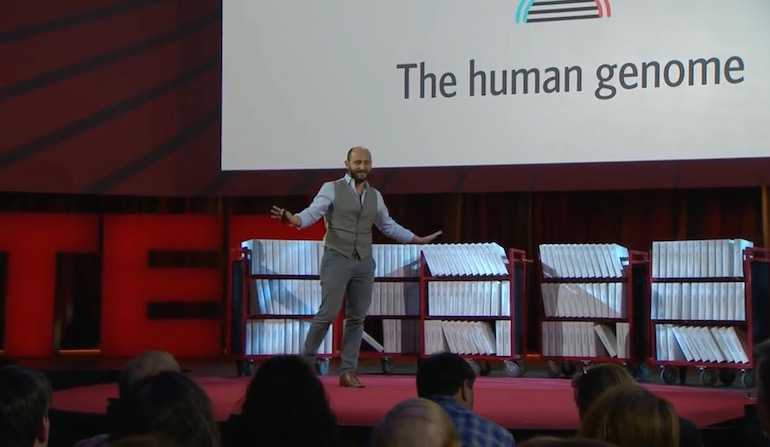 Evolution
Evolution
 Intelligent Design
Intelligent Design
In a TED Talk, Here’s the Question You May Not Ask

It’s remarkable the huge question that a scientist like Riccardo Sabatini can leave unasked — unmentioned — in a 16-minute TED Talk. Watch his presentation on “How to read the genome and build a human being.”
Sabatini is charming. He has the TED style down (who teaches them all to talk that way?), and he deploys some memorable images. He points out that the information to build a human infant, atom by atom, would take up the equivalent of enough thumb drives to fill the Titanic, multiplied by 2,000. Later he wheels out the entire genome, in printed form, of a human being, specifically fellow scientist Craig Venter:
[F]or the first time in history, this is the genome of a specific human, printed page-by-page, letter-by-letter: 262,000 pages of information, 450 kilograms.
That’s a lot of information, highly complex and specified, yet not once does he ask the audience who or what generated the information. Maybe that’s because the Darwinian answer, the only one you’d be permitted to offer in a TED Talk, is so staggeringly unpersuasive.
Now compare that to another brief video in which the authors and editors of the new tome Theistic Evolution speak about the challenges to evolutionists posed by the best science available.
Right off the bat, Douglas Axe describes the complexity of a firefly, or a worm, which dwarfs that of an iPhone.
[T]he mere fact that a firefly comes from a single cell that then develops into a firefly puts it in a completely different league [from an iPhone]. That doesn’t happen with smartphones. Factories make smartphones. Fireflies come from fireflies and come from an initial fertilized cell. It’s absolutely mind-boggling. We have no idea how a single cell produces an adult. These things are marvelous.
Truly mind-boggling and marvelous, yet the obvious question here is not allowable for discussion in most academic settings, never mind a TED talk.
It’s not only a matter of complexity or sophistication. There are also fundamentally unsolvable problems from a materialist perspective. In the video, Ann Gauger briefly summarizes one chicken-and-egg dilemma, which takes us back to the origin of life itself:
[T]o get the first cell, you need DNA and you also need RNA and you need protein. You need DNA to make RNA to make protein, but you also need protein to make DNA. Coming up with that out of a process of random mutation and natural selection is just not possible.
“This is the miracle of life,” as Dr. Sabatini puts it. Indeed, but whose “miracle” is it? How did it happen? The answer, to be mentionable, requires nonsensically personifying nature. He says:
[N]ature, fortunately, is much smarter than a young physicist [as Sabatini once was], and in four billion years, it managed to pack this information in a small crystal we call DNA. We met it for the first time in 1950 when Rosalind Franklin, an amazing scientist, a woman, took a picture of it.
To be “scientific,” the answer to the ultimate question of biological origins must be rendered as a joke. “Nature” is “smart,” but sometimes you get the impression that evolutionists don’t think the public is particularly bright if we’re expected not to see the disconnect here.
